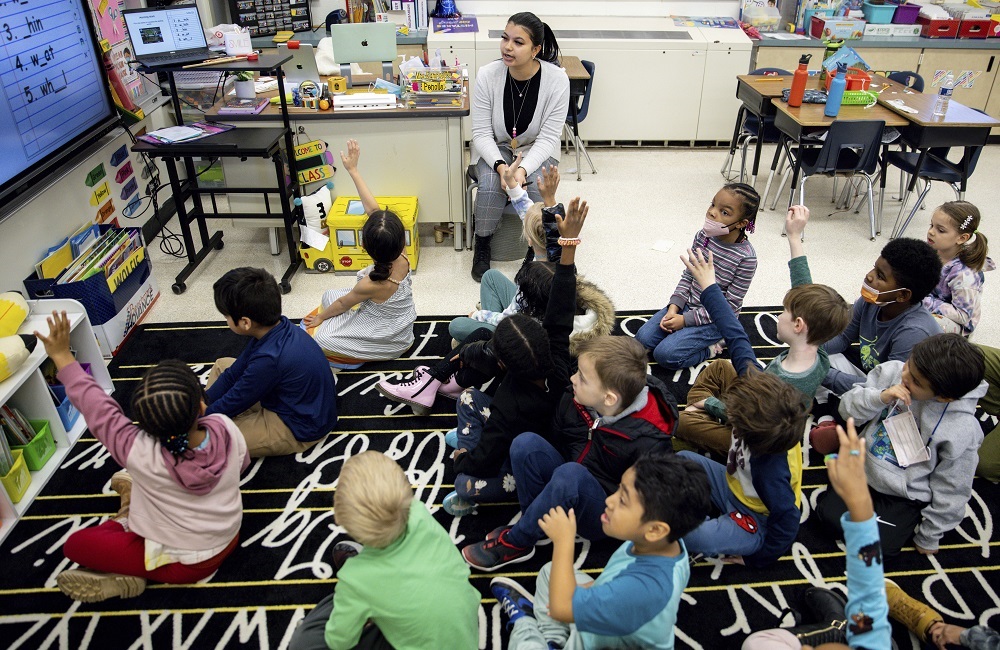On a pretty fall day in Massachusetts last week, Morad Majjad began work by checking in with a middle school nurse to see if he was needed as a translator.
By the time the day was over, Majjad — whose title is family liaison for the West Springfield school district but who is better described as ‘”interpreter-in-chief” — had translated for a misbehaving elementary school child, explained to a librarian’s class in another language how to check out and return books, dropped into a kindergarten class with newly arrived refugees who had trouble understanding what they had to do, and jumped onto a rowdy school bus to discuss proper behavior with a group of immigrant kids new to riding the bus.
“At the end of the day, I’m exhausted, but it makes me fulfilled,” said Majjad, a native of Morocco who speaks five languages — Arabic, Berber (a language spoken by many people in Morocco and Algeria), French, Spanish and English — and who is learning Portuguese. “Last year, I helped 300 families. This year, I think I will be able to affect the lives of many, many more kids.”
The West Springfield, Massachusetts, school district has seen an overwhelming influx of immigrants in the past couple of years, as have other towns in Massachusetts.
Democratic Gov. Maura Healey declared a state of emergency in August because of the rising number of migrant families and called on the federal government for help. She announced in August that Boston and the state will share a $1.9 million grant from the Federal Emergency Management Agency to expand shelters and transportation for the new immigrants. But that did not include money for schools. The state is providing schools with extra money for students housed in emergency shelters.
An increase in immigrant kids has created challenges for schools in areas that have seen a recent wave of migrants, from Texas to Illinois, Massachusetts to Florida.
Julie Sugarman, associate director for K-12 education research at the Migration Policy Institute, a nonprofit research group, said while many school districts have been dealing with English learners and migrants previously, the wave of the past few months means states are trying to provide guidance to schools without knowing exactly when and from where new students are coming.
“Finding [educators] with the right credentials can be challenging,” she said. “Having students come throughout the year is incredibly challenging.”
Take Chicago, for example. A census of the Chicago Public Schools, updated last week, showed that the “English learners” population grew nearly 11% from last fall to this fall, increasing 7,810 to reach 79,833, according to information provided by the district.
In a typical school year, the district said, there are about 3,000 new English learners, though not all are from migrant families.
The Chicago school district is ramping up recruitment and hiring of educators with bilingual skills. As of the 2022-23 school year, it has about 850 teachers with bilingual credentials and 2,100 teachers with both bilingual and English as a second language credentials, the department reported, up from about 2,100 in 2017.
In the Miami-Dade County School District in Florida, 7,519 new students from other countries had enrolled this year as of Sept. 9, spokesperson Ana Rhodes said in an email. That compares with 13,941 from other countries who enrolled throughout last school year, and 7,436 in 2021-22, she said.
This fall in New York City, a reported 20,000 new migrant students enrolled in public schools.
Increased costs
A large infusion of new immigrant families adds to the costs of schools but not greatly to the tax base that funds them, said Steve Camarota, director of research for the Center for Immigration Studies, a national research and advocacy group that favors reduced immigration. In general, schools are financed by local property taxes, though states and the federal government contribute. In some cases, he said, the increased costs are marginal — buying more equipment and books, for example — but others require capital expenditures such as new school buildings.
“With the influx of refugees, it’s been a challenge because the state and agencies don’t know how many are coming, they don’t know the grades they are in, they just show up here.”
West Springfield, Mass., Superintendent Stefania Raschilla
In addition to language issues, there is a “lack of familiarity with American culture, American education, American ideals,” he added. Those aspects all play into school employees’ work, such as the translations Majjad does in West Springfield. Camarota noted that while the kids generally pick up a new language quickly, parents and other family members acquire language more slowly.
West Springfield Superintendent Stefania Raschilla said the stock of materials she buys every year is based on a set number of students. “With the influx of refugees, it’s been a challenge because the state and agencies don’t know how many are coming, they don’t know the grades they are in, they just show up here,” she said in an interview.
She said space in classrooms, space in buildings, transportation and more than 50 different languages students speak at home are among the other challenges.
She hired a few more English as a second language teachers, anticipating the wave.
Massachusetts and New York City attract many immigrants because of mandates requiring that all people have access to shelter. New York Democratic Mayor Eric Adams recently asked a judge to suspend the requirement, in the face of overwhelming immigration.
Access to education
Every kid in the U.S. is entitled to an education, no matter how they came to live here. That’s because of a Supreme Court ruling about 40 years ago, in Plyler v. Doe, that said all children are entitled to a free public education, regardless of immigration status.
In 2022, Texas Gov. Greg Abbott, a Republican, suggested that the ruling might be ripe for overturning. In comments on Texas radio and to local media, he said that states either should be able to set their own immigration policies, or the federal government should pay for the public education of children without legal status.
In Liberty County, a northeast exurb of Houston, where the immigrant population more than doubled between 2017 and 2022, the Cleveland Independent School District has been unsuccessful in trying to get bond issues passed to build new schools. Undaunted, the school district is seeking $125 million with a bond question this fall.
Matt Bieniek, spokesperson for the school district, which serves Liberty County, said the district now has 66 portable classrooms and may have to order more. He said because a state law requires the bond question to be described as a “property tax increase,” people were put off by it, even though it won’t affect property tax rates. But he is hopeful that it might pass this time if there’s better voter turnout.
He said most of the new immigrant population lives in a residential development comprising several subdivisions called Colony Ridge, which has been the subject of discussion by Abbott and the legislature. Abbott suggested that the large number of immigrants buying homes there might become one of the topics to be addressed in a special legislative session planned for later in October.
But immigration status cannot be a reason to deny someone the right to buy property, noted Allison Tirres, a visiting professor at the Santa Clara University School of Law, who teaches immigration law. She said those immigrants who are buying homes are contributing to the tax base that funds schools. She said the “knee-jerk” anti-immigrant reaction is to “go scapegoating” when schools get crowded.
The school district’s Bieniek said some resentment in the community comes because “you have some pushback from the community who want things to be the way they always were. We are doing everything we can to continue the small-town feel,” he said, “while getting our community adjusted to the change in the district.”
(Editor’s note: This story has been updated to note Massachusetts’ funding for schools with migrant students.)
***
Stateline is part of States Newsroom, a nonprofit news network supported by grants and a coalition of donors as a 501c(3) public charity. Stateline maintains editorial independence. Contact Editor Scott S. Greenberger for questions: info@stateline.org. Follow Stateline on Facebook and Twitter.






























